Interior Doors
Pocket Door Lock Installation
 Replacing a pocket door latch is not too hard if you get the same size and style that you had before. Replacing the lock will consist of four steps. (1) Purchasing the new latch or lockset, (2) Removing the old latchset, (3) Changing the mortise in the door if required and (4) Installing the new pocket door latch.
Replacing a pocket door latch is not too hard if you get the same size and style that you had before. Replacing the lock will consist of four steps. (1) Purchasing the new latch or lockset, (2) Removing the old latchset, (3) Changing the mortise in the door if required and (4) Installing the new pocket door latch.
Are you sure that you need to replace the lock? See the articles 'Adjusting Pocket Doors' and 'Troubleshooting Pocket Door Problems' for a listing of possible repairs that may solve your problem.
This repair should take less than an hour once you have the new door lock in hand.
Purchasing a Pocket Door Latch
You can find pocket door latches or locks on the internet and at home supply stores. They are about the same price as a conventional lockset.
There are not nearly as many options with pocket door locks as you have with regular swinging doors. You may find the selection and functionality somewhat limited.
When replacing the door lock, you need to get one that is the same size as the old one. There is not a lot of door left around the lock for the cover plates to seat on. A lock that is too small will not cover the mortise. It would be a good idea to take the old lock with you when you go shopping.
Removing the Old Lock
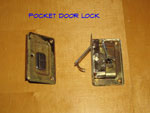 A Pocket door lock is held together with screws. There are probably four screws that are toward the center of the door that hold the lock assembly to the door. Use a screwdriver to take these screws out. The entire assembly should slide out, once the screws are removed.
A Pocket door lock is held together with screws. There are probably four screws that are toward the center of the door that hold the lock assembly to the door. Use a screwdriver to take these screws out. The entire assembly should slide out, once the screws are removed.
The three pieces are also held together with screws. It will be one or two on each side.
Preparing the Pocket Door for a New Latch
The new lock should have a template for the mortise. Check the old opening to make sure you don't have to trim it. Use a sharp chisel to trim it if necessary. After you're sure the opening is the right size you can install the lock. Slide the lock into place and install the screws.
You may have to chisel out the mortise for the strike plate. Mark the outline with a pencil and use the chisel to remove any wood that is in the way. Screw the strike plate in and check the door to make sure the lock is working. Adjust the door as needed.
Installing the New Pocket Door Latch
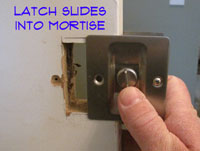 Dry fit the new lockset in the mortise to make sure that it fits correctly. If there are any interferences, chisel or file them away until the lock fits in place properly.
Dry fit the new lockset in the mortise to make sure that it fits correctly. If there are any interferences, chisel or file them away until the lock fits in place properly.
The lockset is made of three pieces. The center piece is the actual latch and can only be installed one way. You want to make sure that the latch comes out and goes down when the knob is turned. Use the thumbset to make sure you have it turned the right way.
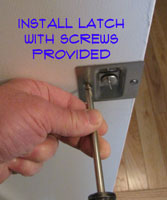 The thumbset should go on the side of the door that is inside of the room. Remove the screws and switch them around if they are the wrong way. The two outer plates are interchangeable, screw the lockset together with the thumbset facing into the room and the privacy function facing out.
The thumbset should go on the side of the door that is inside of the room. Remove the screws and switch them around if they are the wrong way. The two outer plates are interchangeable, screw the lockset together with the thumbset facing into the room and the privacy function facing out.
Once you are sure that the pocket door latch if assembled correctly you can slide it into the mortise. Install the screws into the holes and then check the action.
Replacing a Pocket Door Latch - Summary
Replacing a locks on a pocket door should not have taken you too long, once you found a replacement. We hope this article helped to get your pocket door lock installed correctly. Still having problems?
Pocket Door Adjustment
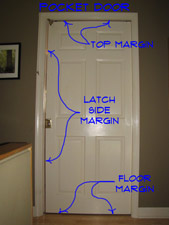 A common problem with pocket doors is difficulty getting the door to latch. The locksets for pocket doors are pretty sensitive and do not allow much of a margin for error. Pocket door adjustment is needed to correct height and alignment issues. When you are working on a latch, the height is a critical concern.
A common problem with pocket doors is difficulty getting the door to latch. The locksets for pocket doors are pretty sensitive and do not allow much of a margin for error. Pocket door adjustment is needed to correct height and alignment issues. When you are working on a latch, the height is a critical concern.
Not sure if this is your problem? See the articles, 'Troubleshooting Pocket Doors' and 'Pocket Door Off Track' for some common pocket door probems. For a discussion on common door problems, see 'Fixing Residential Doors'.
Troubleshooting Pocket Door Adjustment Problems
To adjust the latch, you need to get the height of the door lined up with the strike plate correctly. See next section for instructions.
When the catch won't engage it usually means that the strike plate and the catch are not aligned properly.
Bring the door as close as you can to the strike plate and work the lock to see whether the tongue on the catch is too high or too low. The catch acts like a hook to hold the door closed when it is engaged.
If your door is too low, possibly scraping the floor, you will need to raise it. You will need to be careful, too much change in the height of the door may cause the pocket door latch to not work.
When the door has a gap along the side, the adjustments can get a little tricky. You need to understand how the door reacts when you raise or lower only one side. See the heading 'Adjusting Pocket Door Side Margins', below.
Pocket Door Height Adjustment
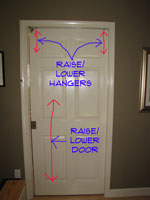 The way that a pocket door is installed allows for adjustments on the height. A standard hinged door cannot be adjusted this way.
The way that a pocket door is installed allows for adjustments on the height. A standard hinged door cannot be adjusted this way.
You need a wrench to adjust the hangers on a pocket door. There is a relatively narrow space at the top of the door where the nut is on the hanger. Most pocket doors will have two hangers. See 'Pocket Door Wrenches' and 'Pocket Door Hangers' for additional information.
Turning the nut clockwise will raise the door and counterclockwise will lower it. When you are adjusting the height you want to turn each nut the same amount. Rasing one hanger more or less than the other one will cause the door to be crooked in the opening.
Turn each nut one full turn and check you height. Continue to raise or lower the door until the desired height is reached.
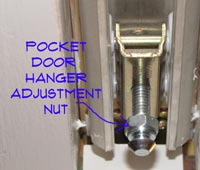 Be careful when you raise or lower the door, it may affect the operation of the pocket door latch. Raising the door may seem like a logical choice when you add new flooring. However, raising it that much will likely cause the lockset to stop working. It is better to trim the door at the bottom, instead of trying to raise it.
Be careful when you raise or lower the door, it may affect the operation of the pocket door latch. Raising the door may seem like a logical choice when you add new flooring. However, raising it that much will likely cause the lockset to stop working. It is better to trim the door at the bottom, instead of trying to raise it.
Adjusting Pocket Door Side Margins
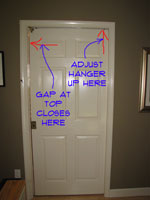 The side adjustments on a pocket door work differently than you might think. If the gap in your door is not too bad, you are only going to want to adjust one of the hangers on the door, preferably the one farthest from the door latch. See 'Pocket Door Wrenches' and 'Pocket Door Hangers' for additional information.
The side adjustments on a pocket door work differently than you might think. If the gap in your door is not too bad, you are only going to want to adjust one of the hangers on the door, preferably the one farthest from the door latch. See 'Pocket Door Wrenches' and 'Pocket Door Hangers' for additional information.
The gap along the side of the door is going to be at either the top or the bottom. I will describe this with words, but you want to look at the pictures to get a sense of what is happening.
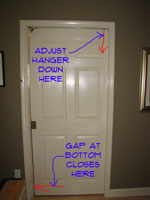 If the gap is at the top of the door, you want to raise the door at the hanger that is farthest away from the latchset. Use the pocket door wrench and turn it one quarter to one half turn at a time until the door is parallel with the jamb.
If the gap is at the top of the door, you want to raise the door at the hanger that is farthest away from the latchset. Use the pocket door wrench and turn it one quarter to one half turn at a time until the door is parallel with the jamb.
For a gap at the bottom of the door, you want to do the exact opposite. Lower the door at the hanger that is farthest away from the door latch. This will cause the bottom of the door to move toward the jamb, closing the gap. Turn it one quarter to one half turn at a time until it is aligned properly.
You may need to make some minor adjustments to the height of the door after you have corrected the margin. Check the operation of the lockset and adjust accordingly.
Pocket Door Adjustment Summary
Once your pocket door is adjusted properly, you want to make sure it is latching correctly. See the articles 'Troubleshooting Pocket Door Locks' and 'Pocket Door Guides' for instructions and information.
Adjusting a pocket door is not that difficult if you still have the wrench that came with the door. Once you understand how the door moves, adjustments are easy.
Fixing a Pocket Door Latch
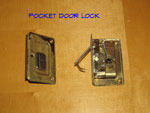 Fixing a pocket door latch will often involve some adjustments to the pocket door. When the door and the strike plate are not aligned correctly, the door will not latch. Sticking or stiff pocket door latches can be lubricated to get working freely.
Fixing a pocket door latch will often involve some adjustments to the pocket door. When the door and the strike plate are not aligned correctly, the door will not latch. Sticking or stiff pocket door latches can be lubricated to get working freely.
For related information, see the articles 'Troubleshooting Pocket Doors', 'Adjusting Pocket Doors' and 'Fixing a Pocket Door Off the Track'.
Pocket Door Latches and Locksets - General Information
Most pocket door locks are not locks at all. They are more like latches. They offer a level of privacy when the door is closed. But it is not that hard to open them from the other side.
A pocket door latch or lockset differs from a normal door lock. A standard door lock has handles or knobs that protrude out of the door. A pocket door has to slide into a narrow pocket that is built into the wall. There is no room for knobs. What do you do?
For this reason a special type of latch or lock was designed for this type of door. The lock is flush with the door panel. It has insets in it for a thumb turn or sometimes a sliding mechanism. The thumb turn or slide operates the latch. When the door is closed there is a flip handle that acts as a pull. Otherwise you would not be able to get the door open.
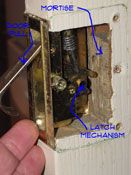 Pocket door locks have similar problems to regular locks. They can become misaligned and the mechanism inside can get stiff. Another thing to note is that a pocket door lock is mortised differently than a standard door. When purchasing a new door slab, you don't want to get one that is bored for a standard door. Simple lubrication and adjustment will solve most problems with this type of lock.
Pocket door locks have similar problems to regular locks. They can become misaligned and the mechanism inside can get stiff. Another thing to note is that a pocket door lock is mortised differently than a standard door. When purchasing a new door slab, you don't want to get one that is bored for a standard door. Simple lubrication and adjustment will solve most problems with this type of lock.
Fixing a Pocket Door Latch - The Issues Involved
What Can You Save? - Lubricating a lock and adjusting a door will take only a few minutes for a carpenter. He will charge you for coming out and this could run $50 to $75. Replacing a lock will run $75 to $100.
How Hard Could It Be? - A pocket door lock is a fairly simple device, most repairs are not hard. These repairs will have a Difficulty Level of: Simple. These repairs require a Skill Level of: Handyman. For and explanation of the terms in this section, see 'How to Use This Site'.
Check the Simple Things! - Lubricating the lock is the simplest thing you can do. A stiff or frozen lock will likely respond to some silicone lubricant.
What Can Go Wrong? - Be careful when you take a lock apart. Losing a part could cause the lock to quit working. Adjusting the door the wrong way can cause the lock to quit working altogether.
Lubricating a Pocket Door Lock

Lubricating a pocket door lockset is not too hard. However, you do have to take the latch apart to get to most of the parts that need attention. Latches and locksets that are sticking or making noise need lubrication.
Before you begin lubricating your pocket door latch you want to have a can of lubricant that is suitable for door locks. A silicone based lubricant is best. You also want to have a rag on hand to wipe up any excess oil.The lock assembly probably consists of three parts. The center latch mechanism.
This mechanism also has the flip out handle that acts as a door pull. The other two parts are the cover plates. Each plate has a thumb screw or slide that operates the latch.
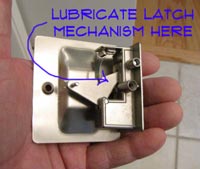 You want to use a good quality silicone spray to lubricate locks. Use the long slender tube that comes with most spray lubricants. Keep a rag handy to wipe up any excess oil.
You want to use a good quality silicone spray to lubricate locks. Use the long slender tube that comes with most spray lubricants. Keep a rag handy to wipe up any excess oil.
Gingerly spray the oil into the moving parts. Work the latch back and forth until it moves freely. Make sure you oil all the parts including the slides or thumb screws. Use the rag to wipe up any excess oil. When you are sure the lock is working properly, you can put it back in.
Removing the Pocket Door Latch
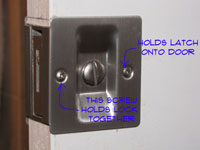 A Pocket door lock is held together with screws. There are probably four screws that are toward the center of the door that hold the lock assembly to the door. Use a screwdriver to take these screws out. The entire assembly should slide out, once the screws are removed.
A Pocket door lock is held together with screws. There are probably four screws that are toward the center of the door that hold the lock assembly to the door. Use a screwdriver to take these screws out. The entire assembly should slide out, once the screws are removed.
The three pieces are also held together with screws. It will be one or two on each side. You probably do not need to take these screws out. With the lock out of the door, you can inspect it to see what your problem might be. If nothing is broken and the lock is just difficult to operate, lubrication is the likely answer. See the next step.
Lubricating the door lock should have taken care of any noise or sticking problems with your latch. We hope this article helped to get your pocket door working properly.
Troubleshooting Pocket Door Latch Problems
Trouble with the latch closing is usually tied to the alignment with the strike plate. Pocket doors can be adjusted, unlike conventional swinging doors. The article 'Adjusting a Pocket Door' gave you instructions on how to get the door aligned properly.
When all else fails, you can replace your latch. There are not a lot of choices with this type of hardware. In the article on 'Replacing a Pocket Door Latch' we covered purchasing and installing a new lockset.
Summary
We hope that this article helped with your pocket door lock. You should have been able to take care of your problem without too much trouble.
So what did you find out about your pocket door lock? Did it just need to be oiled. Many times a little lubrication is all that is needed. Was the strike plate not lining up with the latch? Again a simple adjustment should have taken care of this problem.
Replacing the lock is often done when the old one gets tired looking. This is not a big job either, as long as you get a lock that is the same size. Now that you have completed this task you can look for other home repair projects.
Hopefully you have been able to take care of the issues with your pocket door latch.
Replacing Pocket Door Rollers
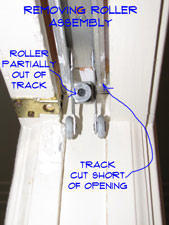 Replacing pocket door rollers is not too hard if you have the right ones to replace them with. There are some concerns with attempting to replace the rollers.
Replacing pocket door rollers is not too hard if you have the right ones to replace them with. There are some concerns with attempting to replace the rollers.
Pocket Door Rollers - Standards
You might think that something as common as pocket doors, that there would be some standards. Unfortunately, there are not.
See the article 'Issues With Pocket Door Track', for additional information.
How Pocket Door Rollers Work
Pocket door rollers keep the door running inside of a metal track. The rollers are made of metal and nylon and usually have three or four rollers on each assembly. Regular doors are supported by hinges. The hinges are attached to the side of the door. A pocket door has hangers that are attached to the top of the door with metal brackets. Like any wheel that uses bearings, lack of lubrication can cause them to wear out and start to tighten. When this happens the door becomes hard, sometimes impossible, to move.
The door rollers need to be able to ride in the grooves in the track. The track is 'C' shaped with the sides curled up to form a groove. The style of roller usually matches the metal track that they ride in. Finding rollers that are an exact match for the ones that you have may be challenging. You can buy kits that have new track included. The problem is that unfastening and installing the track inside the pocket is pretty hard.
Removing Pocket Door Rollers
The rollers and the track need to match, otherwise, they won't work, or they will work very poorly. So you need to make sure you get the correct ones before you remove the old ones.
See the article 'Removing Pocket Door Rollers' discusses how to take off the door and remove the rollers. You might want to get some help, before you attempt to remove the door.
Most of the time, replacing the rollers is not practical or even possible. Lubrication will usually get them working again. See the article 'Lubricating Pocket Door Rollers' for more information. It could be that a little oil will solve your problem.
Replacing the Rollers
With the door removed it is easy to replace the rollers. There is an opening at the end of the support track on the strike side of the door. Tilt the roller assembly into the opening, moving it into the track until the wheels start to roll in the track. Continue to move the roller toward the middle of the door opening, tilting it until the second set of wheels engages the track. Move it into the track until all the wheels are in the grooves in the track. move the roller back and forth to make sure it is working freely.
Move the first roller toward the far side of the door. Repeat the process with the second roller. Again, check to make sure both rollers are working freely.
Putting the Door Back On
Getting the door back on the hangers is a little tricky. See the article 'Putting a Pocket Door Back on Track' for information and instructions.
Lubricating Pocket Door Rollers
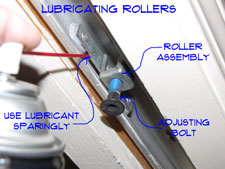 Lubricating pocket door rollers is a wise maintenance activity. A little oil installed once or twice a year will keep the door operating correctly.
Lubricating pocket door rollers is a wise maintenance activity. A little oil installed once or twice a year will keep the door operating correctly.
Not sure if this is your problem? See the article 'Troubleshooting Pocket Door Problems' for a complete listing of subjects on pocket doors. Having trouble with the pocket door opening and closting, see 'Replacing a Poc ket Door Off the Track' and 'Removing a Pocket Door' for instructions on what to do.
Most doors will have two sets of rollers that glide in the track. The rollers will typically have three or four wheels.With that many wheels it is easy to see how problems could arise.The rollers are not technically part of the pocket door track. They are, however, matched to the track. To keep them working smoothly, you need to lubricate them periodically.
Using the Right Lubricant
You want to use a lubricant that has silicone in it. The wheels are made of nylon and you do not want anything that is too strong or will damage the wheels.
Another concern is making a mess. Do not use grease or any lubricant that does not dry clear. Although the intent is to just put the oil on the rollers and track, it is possible that you will get some on other surfaces. Make sure it is an spray type that can be easily cleaned off of other surfaces.
Formulated with Teflon™ Fluoropolymer to enhance performance. Its clear, non-evaporating formula eliminates wear from constant friction and is safe and non-staining.
Blaster makes some products that are suitable. However, they are not the only ones that can be used. Try to locate a spray lubricant with similar properties.
'Blaster Garage Door Lubricant' is a silicone-based lubricant that leaves a tack-free film that won't accumulate dust and dirt. It effectively helps stop squeaks associated with garage doors and mechanisms. 'Blaster Silicone Lubricant' contains a higher concentration of silicone than competitor brands, which provides longer-lasting lubrication. Both product boast that they won't accumulate dust & dirt and that they quiet noisy operation of moving parts.
Purchasing Lubricant
Most home supply and hardware stores will have lubricants that will work for a pocket door. See the section above on choosing the right type. You can also find them online if you want to purchase a specific one.
A can of spray silicone lubricant should run around $5 to $10 and will last for quite a while. This type of lubricant is good for several household chores.
Cleaning the Rollers and Track
Before you apply any oil, you are going to want to make sure that the rollers are free of dust and dirt. You will also want to make sure that the track is free of dirt and build up.
To clean up the rollers, you will need to remove them. See the article on 'Removing and Replacing Pocket Door Rollers' for instructions on what to do.
Oiling the Rollers
Before you start make sure that you have a can of silicone spray and a rag. The rag will help to keep from getting the oil or spray on other surface. It will also be handy to wipe up any over spray or drips that may occur.
Carefully spray the rollers and the track. Do not use too much, but try and get an even coating. Move the door back and forth to work the lubricant into the nooks and crannies.
If the door still does not operate smoothly, add some more spray until the operation is smooth. If the rollers will not free up, they may need to be replaced, see the article 'Replacing Pocket Door Rollers' for more information.
Summary
Periodically oiling or lubricating the hardware on a pocket door is a good practice. The main moving part for the door is the two hanger/roller assemblies that roll along a track at the top of the door.


